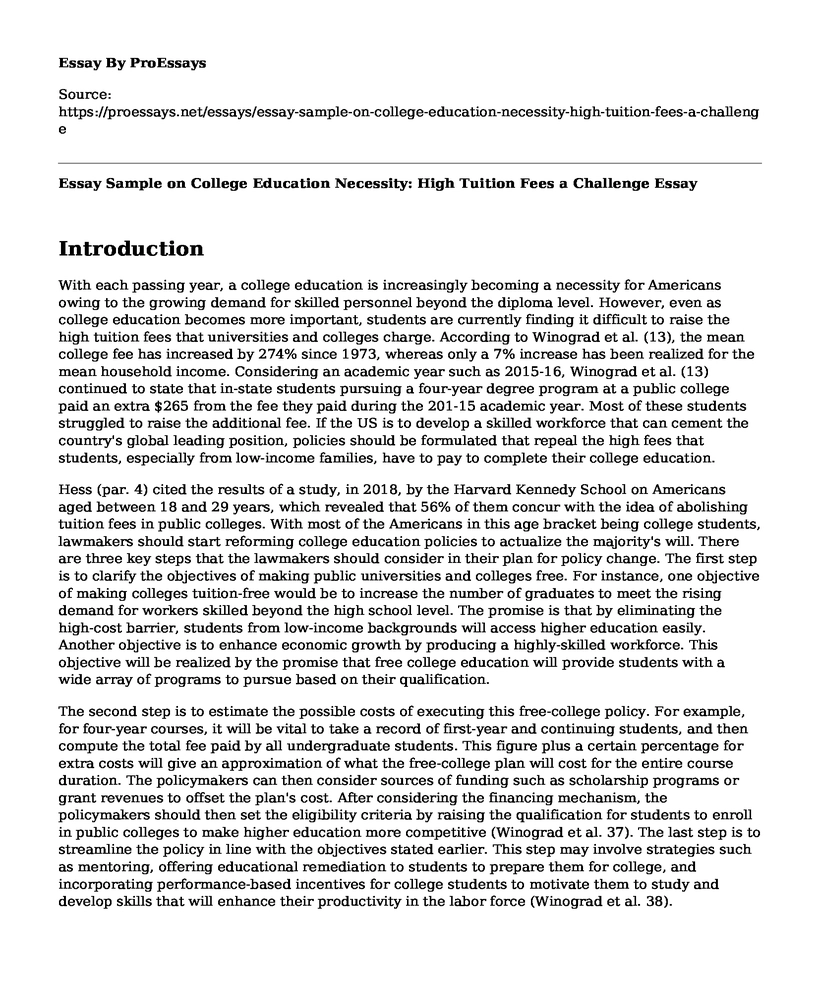Introduction
With each passing year, a college education is increasingly becoming a necessity for Americans owing to the growing demand for skilled personnel beyond the diploma level. However, even as college education becomes more important, students are currently finding it difficult to raise the high tuition fees that universities and colleges charge. According to Winograd et al. (13), the mean college fee has increased by 274% since 1973, whereas only a 7% increase has been realized for the mean household income. Considering an academic year such as 2015-16, Winograd et al. (13) continued to state that in-state students pursuing a four-year degree program at a public college paid an extra $265 from the fee they paid during the 201-15 academic year. Most of these students struggled to raise the additional fee. If the US is to develop a skilled workforce that can cement the country's global leading position, policies should be formulated that repeal the high fees that students, especially from low-income families, have to pay to complete their college education.
Hess (par. 4) cited the results of a study, in 2018, by the Harvard Kennedy School on Americans aged between 18 and 29 years, which revealed that 56% of them concur with the idea of abolishing tuition fees in public colleges. With most of the Americans in this age bracket being college students, lawmakers should start reforming college education policies to actualize the majority's will. There are three key steps that the lawmakers should consider in their plan for policy change. The first step is to clarify the objectives of making public universities and colleges free. For instance, one objective of making colleges tuition-free would be to increase the number of graduates to meet the rising demand for workers skilled beyond the high school level. The promise is that by eliminating the high-cost barrier, students from low-income backgrounds will access higher education easily. Another objective is to enhance economic growth by producing a highly-skilled workforce. This objective will be realized by the promise that free college education will provide students with a wide array of programs to pursue based on their qualification.
The second step is to estimate the possible costs of executing this free-college policy. For example, for four-year courses, it will be vital to take a record of first-year and continuing students, and then compute the total fee paid by all undergraduate students. This figure plus a certain percentage for extra costs will give an approximation of what the free-college plan will cost for the entire course duration. The policymakers can then consider sources of funding such as scholarship programs or grant revenues to offset the plan's cost. After considering the financing mechanism, the policymakers should then set the eligibility criteria by raising the qualification for students to enroll in public colleges to make higher education more competitive (Winograd et al. 37). The last step is to streamline the policy in line with the objectives stated earlier. This step may involve strategies such as mentoring, offering educational remediation to students to prepare them for college, and incorporating performance-based incentives for college students to motivate them to study and develop skills that will enhance their productivity in the labor force (Winograd et al. 38).
Conclusion
On implementing this policy, there are several ways through which students will benefit. First, their income status will not prevent them from enrolling in college, studying, and graduating. The students will access higher education easily and focus on their studies with less financial worries. Also, after graduating and securing decent jobs, the free-college plan will protect students from distress that is sometimes caused by the burden of repaying student loans. Lastly, students will have more free will in selecting courses and majors that they desire to pursue since the financial aspect always constrains most students' choices.
Works Cited
Hess, Abigail. "51% of Young Americans Support Tuition-Free Public College". CNBC, 2019, https://www.cnbc.com/2019/10/01/56percent-of-young-americans-support-free-public-college-how-it-might-work.html.
Winograd, Morley et al. "Making Public Colleges Tuition Free: A Briefing Book for State Leaders". D3n8a8pro7vhmx.Cloudfront.Net, 2016, http://d3n8a8pro7vhmx.cloudfront.net/themes/5734e55178b8e29a74000001/attachments/original/1481562117/CFCT_BriefingBook_2016.pdf?1481562117. Accessed 25 Nov 2019.
Cite this page
Essay Sample on College Education Necessity: High Tuition Fees a Challenge. (2023, Mar 07). Retrieved from https://proessays.net/essays/essay-sample-on-college-education-necessity-high-tuition-fees-a-challenge
If you are the original author of this essay and no longer wish to have it published on the ProEssays website, please click below to request its removal:
- Discussion on the Current Research That Links Patient Safety Outcome to ADN and BSN Nurses
- Why Children Should be Given Less Homework Essay
- The Freedom to Be Me Essay Example
- Research Paper on Difference Between the Unique, Mainstream, and Inclusive Schools
- Essay Example on Data Literacy: Propelling Workforce to Success
- Free Essay on Navigating Societal Norms: An Exploration of Social Interaction through Eye Contact
- Report Example on Exploring Roles and Occupations: A Reflection on Motherhood and Well-Being







